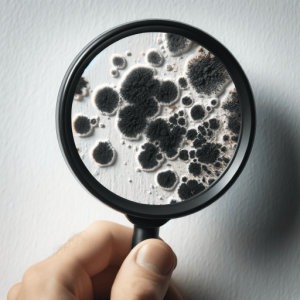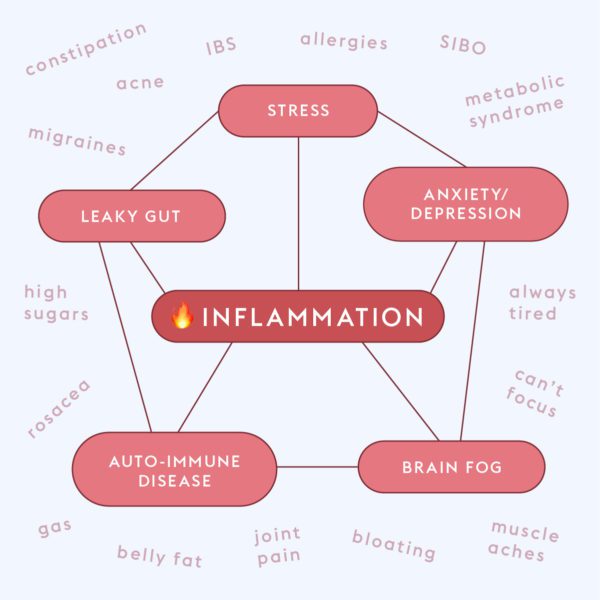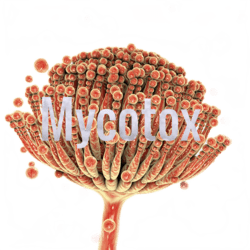Treated Chronic Inflammatory Response Syndrome (CIRS), with Improved Outcomes in Polycythaemia vera utilizing Portable Photocatalytic Oxidation
ABSTRACT
This paper describes a case study of a client diagnosed with chronic inflammatory response syndrome (CIRS) due to water-damaged buildings (WDB) and concurrent development of Vince. Both illnesses improved with the use of portable photocatalytic oxidation (PCO) air filtration device in the clients’ home.
We hypothesise the improvements in the blood cancer was due to the very low-level hydro-peroxides and negative ion production from the PCO units causing favourable gene expression/downregulation especially in the JAK2 pathway leading to apoptosis of cancerous cells via or along with upregulation of p53 (ref1), in addition to the removal of inflammatory compounds/triggers in the clients’ environments.
CIRS maybe a common inflammatory pathway which due to gene expression changes from that exposure, the downstream effect on other genes could be resulting in a myriad of other diseases developing.
Introduction:
Chronic Inflammatory Response Syndrome (CIRS) was first identified as an illness by Dr Ritchie Shoemaker in 1997[1]. CIRS is s a multi-system, multi-symptom illness caused by inhaling biotoxins, VOCs, MVOCs and other inflammagens produced by micro-organisms such as mould or bacteria, which may include endotoxins from gram negative bacteria, actinomycetes part of gram-positive bacteria. Particles from all these organisms are referred to as PAMP’s (pathogen associated molecular patterns) and can induce an immune response. It also must be understood that some of these organisms carry mycoviruses, viruses have Many viruses have acquired sophisticated mechanisms to regulate p53 (ref2), leading to possible downstream gene expression changes.
Catalytic Air Treatment is a way to improve the quality of air, in indoor environments inhabited by CIRS affected individuals. It uses Specific wavelength LED lights to ionize air and eliminate Volatile organic compounds (VOC’s) and produce extremely low-level hydro-peroxides.
Improvements in disease states with the use of PCO unit
Over the last 6 years we have seen so many individuals with chronic inflammatory response illness, who have had positive improvements when we utilize a catalytic portable air system, the result is even greater when you remove all known building contamination. This contamination is not limited to mould and bacteria, but the chemicals produced by these organisms or other chemicals from man products within the builtin environment
Knowing the pathways and perhaps even more importantly being able to determine how to further improve those results, led us to set up a small clinical study to include 6 individuals with a chronic inflammatory response in which we were able to show that over an 8-hour period with a catalytic air system there were improvements at a gene expression level as well as C4a and VCS levels.
Seeing improvements at a gene expression levels does beg the question as to what is happening downstream or upstream due to refunctionalizing of gene expression by using the catalytic clean air system.
Dr Jimmy Ryan who undertook the gene expression testing, showed in some of the individuals the start of refunctionalization of gene expression had begun after only 8 hours with a catalytic system.
Those changes were strong in the Ribosomal small and large sub-units and that’s where protein misfolding can occur. Protein misfolding diseases can include Phenylketonuria and Parkinson’s disease(refaa)
In layman’s terms we are perhaps seeing that inflammation can cause positive upregulation or down regulation of gene expression (dysregulation), increasing evidence also indicating that brain inflammation is involved in the pathogenesis of neuropsychiatric diseases, including Alzheimer’s, Parkinson and Autism [3,]
The positive change in gene expression maybe associated with the catalytic process producing low levels of hydro-peroxides (HPs), negative ions and those HPs could be the signalling compound that is activating the immune system which has the ability to advantageously change the gene expression to facilitate disease reduction. Or that by simply removing inflammatory triggers, the body’s immune system is better positioned to heal itself.
An example of that, is where preclinical trials have shown that by upregulation of the major tumour suppressing gene family, p53, may result in tumour shrinkage or even as has been reported, complete tumour regression [Refbbb]. This has been shown using a combination of liquiritin, isoliquiritin and isoliquirigenin induce apoptotic cell death through upregulating of p53, various herbal remedies have shown a similar upregulation of the p53 also inducing apoptosis.
The TP53 protein provides essential functions in the cellular response to diverse stresses and safeguards maintenance of genomic integrity. Can the promotion of apoptosis by upregulating or down regulating certain gene expressions in those genes associated with a disease, lead to removal of mutant miss-folded proteins.
In a human body there is a delicate balance which has to be maintained, between the number of cells dying and number of cells dividing. Apoptosis (programmed cell death or cell suicide) is an important mechanism for regulating cell numbers within a population to maintain the balance between birth and death during development. (Ref 7)
Epigenetics
Epigenetics, has been used to refer to the interactions between the genome and the environment, in the area we investigate i.e., the indoor environment where the microbial profile has changed due to a water intrusion, humidity or simply poor building practices, leading to growth of bacteria and mould over and above the normal indoor flora, as well or in addition too, toxins within water ways can produce similar inflammatory responses. (Ref 10)
Epigenetic modifications have emerged as surrogate markers of environmental exposure, both within a domestic or work environment. Oncology studies, aberrant modifications of DNA methylation have been associated with tumor progression and severity of invasive cervical cancers. The focus of the Jak2/Stat gene and methylation of DNA is what can be referred to as “down-stream” events in epigenetics, the “up-stream” trigger is the up or down modulation of cell-cell communication in tissues. (Ref 7)
A Blood Cancer
Polycythemia Vera is a rare blood cancer which may be associated with Epigenetic modifications, with life expectancy at least 20 years after diagnosis if properly maintained.
PV (Polycythemia Vera) is one of a related group of blood cancers known as “myeloproliferative neoplasms” (MPNs) in which cells in the bone marrow that produce the red blood cells do not develop and function normally.
PV begins with one or more acquired changes (mutations) to the DNA of a single blood-forming cell. This results in the overproduction of red blood cells. Almost all patients with PV have a mutation of the JAK2 (Janus kinase 2) gene. Mutations in this gene are associated with numerous inflammatory diseases and malignancies (ref Jak) In a study of 6 individuals with a chronic inflammatory response we were able to show that over an 8-hour period we saw down regulation in 5 out of 6 compared to where their gene expression was previously the catalytic clean air system, in the Jak2 gene expression before the catalytic air. This down regulation of the JAK2 gene may lead to apoptosis occurring of mutant cells.
We have recorded down regulation of the Jak2 gene expression, in 5 out of 6 after only 8 hours of CAS (catalytic air systems). But what part may the p53 and p21 play.
In our small study group the p53 showed upregulation in all but one after the 8-hour CAS exposure- are there combined downstream events with both the upregulation of p53 and the down regulation of the JAK2 gene or will we find that is the state of play in a healthy body.
Water Damaged Building and One out of Two Developed a Blood Cancer
We have a client in the states who after moving into her house started having inflammatory responses, leading to major vascular issues. Her CBC’s (complete blood count) would show increased red blood cells, she also had several bone marrow biopsies during the last 2 years as well, showing Polycemia. She had an extreme level of a chronic Inflammatory response (CIRS) which was also shown in gene expression which targeted 188 inflammatory genes. (Ref 6)
After positive testing for the JAK2 gene mutations, (which may possibly may have been a downstream event from exposure within the house) along with other blood tests, our client was diagnosed as having PV. This test looks for mutations in the JAK2 genes that are associated with bone marrow disorders caused by an overproduction of blood cells. The only medication she was on for the PV, was small dose aspirin before the use of the catalytic air system CAS and this continued while using the CAS, approximately 6 months before the PV diagnosis, she had a cervical cancer develop which has resolved but did required surgery.
We have been informed our client, in addition to small dose aspirin, did use Medicinal CBD oils, whether there was any synergism between the CBD oils and the catalytic air system would have to be taken into account in any further studies.
Since running the Australian Air Oasis catalytic system 24/7, which she purchased due to her Chronic Inflammatory Response, she hasn’t had any symptoms approximately for the last 8 to 10 months which she could associate with her PV, this decrease in symptoms was only after a couple of months, after she started utilizing the catalytic clean air system. Her chronic inflammatory response symptoms have also during the last 8 months reduced considerably.
All of her blood work has been improved since then, with only once having a slightly elevated haemoglobin /red blood cell count (and it was just very slight and needed no intervention), compared to previously being rushed to hospital over 26 times.
Recent testing by her haematologist which the specialist repeated, showed her PV cancer was no longer there, clotting gone, red blood cells back to normal and her JAK2 mutation, no longer reported, her haematologist said it isn’t possible, the only changes during this time was the CAS machine and a huge improvement in her health due to the CAS machine removing all inflammatory triggers from her environment or was that the CAS producing hydro- peroxides, was triggering/activating the immune response.
The JAK2 gene provides instructions for making a protein that promotes the growth and division (proliferation) of cells. This protein is part of a Signaling pathway called the JAK/STAT pathway, which transmits chemical signals from outside the cell to the cell’s nucleus. The JAK2 protein is especially important for controlling the production of blood cells from hematopoietic stem cells.
Danshen Injection has been shown to significantly inhibit the proliferation, but also induce apoptosis in HEL cells; down-regulation of the mutant JAK2 gene and P-JAK2 protein expressions are probably one of its molecular mechanisms (ref 15). Typical apoptosis cells were observed in Danshen Injection treated HEL cells, the rates of annexin V positive cells increased obviously in a dose-dependent manner, as well as the DNA degradation ladder of apoptosis revealed on gel electrophoresis. The expression levels of mutant JAK2 gene and P-JAK2 protein reduced gradually with increasing dosage of Danshen injection.
In a study where we had individuals exposed to catalytic clean air in a clinical environment, resulting in conditions conducive to further downregulation of the Jak2, this gene was down regulated in 5 out of 6 in our study after only a short period of 8 hours with catalytic clean air. Naturally we can’t show how much further down regulation could occur after 6 weeks which is the time frame where symptoms decreased in our client with PV. These results from our small study group have not been published but the data is available.
The Hypothesis
At this stage we are assuming that we have used the catalytic clean air with hydro-peroxides to provide conditions in which the body was able to down regulated the JAK2 mutant cells, as well as the p-JAK2 protein, resulting in apoptosis of the mutant JAK2 cells. Stable cyclic peroxides are demonstrated to have cytotoxic activity against cancer cells. (Ref 9)
Below the data from our previous study, outlines the down regulation after 8 hours of catalytic clean air system in 5 out of 6 in our previous study.
The study individual PB, whose results showed in a number of gene expressions to be opposite to the others (upregulation or downregulation) which we believe was because of her chemical sensitivity and that she was reacting to a very low level of ozone coming from the original UV tubes in the portable units, these have now been replaced by LED technology, as well as using minor light refraction.
A vivo animal testing study has been suggested, to show if we can see similar apoptosis of the mutant Jak2 cell in a mouse model, which is what was achieved in our client. Removal of the mutant JAK 2 cell in a mouse study will confirm that the portable catalytic air system is indeed the intervention, we will also have to use the study to look at any synergism between CBD oil or even just by itself.
Of concern is that our client developed CIRS while in the building and it would appear that her PV also developed in this building, previously she was extremely healthy before living in a home which had suffered from a constant leaking roof which was hidden before their purchase.
Inflammation which had developed from the home exposure, could only be reduced by removing the source and as part of trying to reduce her exposure, the catalytic clean air process was used to bring about a positive result – the mice to be used in the study have not been exposed to a microbially contaminated environment so that the machine may not produce the same outcome, as the Mutant JAK 2 cell is downstream of other changes. If the study does still show removal through apoptosis, then this doesn’t become an issue and should also help us understand what immune cells have been activated, if that is indeed the pathway.
Control levels shown in green, down regulation after 8 hours shown in blue and up regulation in red- PB one of our study individuals was the only one with upregulation in the four gene expressions below and she did have chemical sensitivities. In around 15,000 genes we looked at, a high percentage of those results saw PB’s gene expression opposite to others in the study. It has to be noted that originally we sued used catalytic lamps which produced a safe level of ozone, after this study we have been using zero ozone compliant led LED lamps.
Below the spread sheet shows that there was down-regulation in 5 out of 6 of those in the study group, the control levels are the first column and before after exposure to 8 hours of a catalytic clean air system.
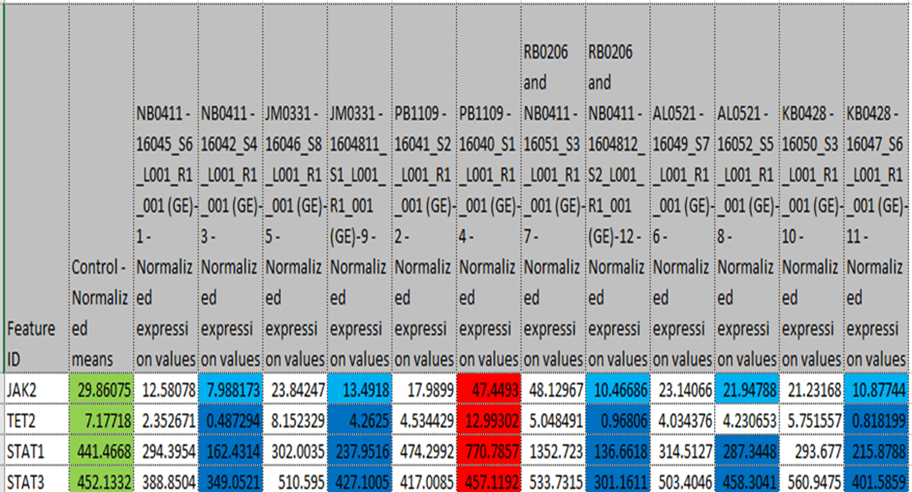
In research, TET2 has been shown to be involved with a low percentage of those with PV. The TET2 gene provides instructions for making a protein whose function is unknown. Researchers believe the TET2 protein is involved in regulating the process of transcription, which is the first step in protein production and the TET2 protein appears to act as a tumor suppressor, which is a protein that prevents cells from growing and dividing in an uncontrolled way.
In a study (ref 1) it was demonstrated that down-regulation of Tet2 was associated with higher methylation level of Foxp3 TSDR, reduction in Foxp3 expression and Treg cells percentage in AR, suggesting that Tet2 probably modulated the function of Treg cells in AR through Foxp3 methylation.
Most in our study results shown above, are from those who were suffering from a chronic inflammatory response and showed down regulation except for study member 2, tabled as JM. Down-regulation has been shown of TET2 in CD3⁺ and CD34⁺ cells of myelodysplastic syndromes (ref2)
Clients History
Our client has had previous gene expression testing (Genie) and now has re-undertaken the gene expression testing, after 12 months of using the Australian Air Oasis portable air system. When those results are available, they will be added to this study and it may provide a better understanding of the improvements she has seen, along with her current diagnosis of now being negative to Polycythemia Vera.
Her exposure began in 2015 when she moved into the current house and found out the water damaged roof had not been addressed but it was simply covered with a new roof. In 2016 our client started to experience inflammatory symptoms and she was diagnosed 2019 with PV. Her Genie which shows gene expression in 188 genes which, have been linked to CIRS did show issues in her coagulation pathways, which is what you would expect with PV, that dysregulation showed FB gene expression was upregulated and THBS1 was partly upregulated this gene expression is positively regulated by several tumor suppressor genes (ref 8), this may suggest that the p53 or p21 expression had been negatively altered.
In the MAP Kinase which are involved in directing cellular responses to various stimuli both MAP3K5, MAPK1 were slightly upregulated and MAPK14 as well as MAPK3 were upregulated. MAPK14 is involved in transcription regulation and development. This kinase is activated by various environmental stresses and proinflammatory cytokines. MAPK 3 act as a signaling cascade that regulates various cellular processes such as proliferation, differentiation, and cell cycle progression in response to a variety of extracellular signals. This kinase is activated by upstream kinases.
Here in our clients Genie, we have upregulation in the IGF1R and IGFLR1 insulin genes and mice studies have shown that IGF1R protein expression/activity was substantially increased in mutant RAS-expressing cells in those with Leukemia. Polycythemia vera can evolve into acute leukemia. Our client’s new genie, we hope it will show that IGF1R and IGFLR1 are no longer upregulated.
Further clinical investigation of IGF1R and RAS signaling inhibition as a potential treatment strategy for RAS-driven malignancies has been discussed by various researchers. It has been known for more than three decades that about a third of all human cancers, including a high percentage of pancreatic, lung, and colorectal cancers, are driven by mutations in RAS genes. (Ref 12). The main members of the RAS gene family— KRAS, HRAS, and NRAS—encode proteins that have a pivotal cytoplasmic role in cell signaling. When RAS genes are mutated, cells grow uncontrollably and evade death signals. RAS mutations also make cells resistant to some available cancer therapies. In our small study which looked at gene expression before and after, both the KRAS and NRAS genes showed downregulation/inhibition, as can be seen below where all but PB showed positives. Of concern is that HRAS gene expression was upregulated and has been shown to be significantly upregulated in clinical BC samples compared to healthy samples (Ref 13). The HRAS gene belongs to a class of genes known as oncogenes. When mutated, oncogenes have the potential to cause normal cells to become cancerous. The RAS proteins play important roles in cell division, the process by which cells mature to carry out specific functions (cell differentiation), and the self-destruction of cells (apoptosis). The H-Ras protein acts like a switch, and it is turned on and off by GTP and GDP molecules. To transmit signals, the protein must be turned on by attaching (binding) to a molecule of GTP.
In our study the use of the machine for 8 hours showed the HRAS to be switched/activated/upregulated, in 5 out of 6 individuals (Ref 14).
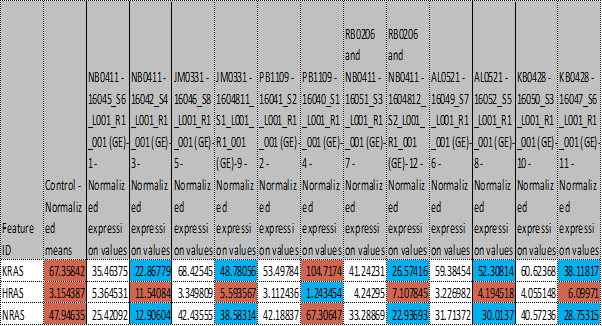
Below are our client’s inflammatory markers through Gene Expression before she started using the catalytic clean air system.
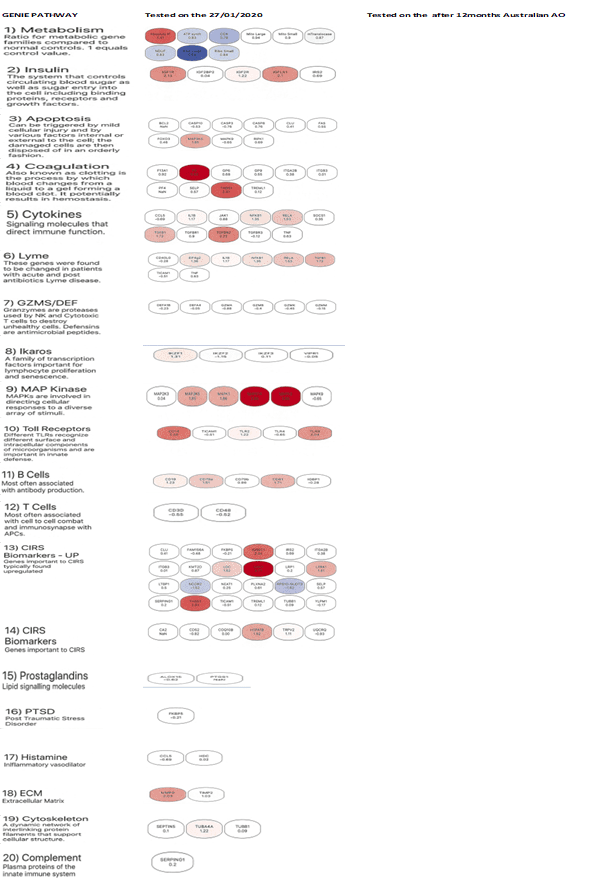
In the above gene expression, you would expect to see changes in the coagulation gene expression and that was seen in that FB was upregulated and THBS1 was partly upregulated, its expression is positively regulated by several tumor suppressor genes (ref 8) does this evidence suggest that regulation by a tumor suppressor gene is not occurring as those TSG have also been dysregulated?
Case Study 2 with Positive Results after PCO
Our company has been involved with another client whose father was living with her and she had numerous water damages, developing a hoarding disorder of her contaminated contents, to the extent that the bath was not usable because of the clutter and the shower was over the bath.
Her father had recently undergone both chemotherapy and radiation treatments, these along with a bad heart had made him very sick. Sometime later after the previous cancers had been treated, St Vincent’s Hospital diagnosed him with 3 lung tumours, he refused any further treatments.
We attended site to install a machine for the client at the request of another client to see if it would help her out and reduce some of the exposures.
In less than 3 months we re-attended to determine what else we could do and our client told us that her dad had been back into St Vincent’s where they were amazed that 2 of the 3 tumours had completely disappeared and the remaining tumour was affected by a bacterial infection. Her dads heart failed later that year and no further testing could be undertaken.
In our very small study, we did see that 5 out of 6 had up regulation of the p53 -our study did not encompass p21
In a study (ref 3) they showed that by upregulating p53 and p21 in the A549 non-small cell lung cancer cells they induce apoptotic cell death. Non-small cell lung carcinoma p53 is also frequently inactivated in NSCLC. Capacity of p53 to restrain early tumour evolution and in the efficacy of therapeutic p53 restoration to eradicate cancers (ref4) The study of p53 tumor-suppressive mechanisms affirmed the important roles of cell-cycle arrest and apoptosis in preventing tumor progression and inducing regression of established tumours (Ref 5).
References:
- Hafner, A., Bulyk, M.L., Jambhekar, A. et al. The multiple mechanisms that regulate p53 activity and cell fate. Nat Rev Mol Cell Biol 20, 199–210 (2019). https://doi.org/10.1038/s41580-019-0110
- Sato Y, Tsurumi T. Genome guardian p53 and viral infections. Rev Med Virol. 2013 Jul;23(4):213-20. doi: 10.1002/rmv.1738. Epub 2012 Dec 17. PMID: 23255396.
- Francesco Panza, Davide Seripa, Grazia D’Onofrio,Vincenza Frisardi, Vincenzo Solfrizzi, Patrizia Mecocci, and Alberto Pilotto-Neuropsychiatric Symptoms, Endophenotypes, and Syndromes in Late-Onset Alzheimer’s Disease: Focus on APOE Gene
- Tan L, Qiu T, Xiang R, Cao C, Deng Y, Tao Z, Xu Y. Down-regulation of Tet2 is associated with Foxp3 TSDR hypermethylation in regulatory T cell of allergic rhinitis. Life Sci. 2020 Jan 15;241:117101. doi: 10.1016/j.lfs.2019.117101. Epub 2019 Nov 25. PMID: 31778687.
- Jak2 JAK2 Janus kinase 2 [ Homo sapiens (human) ]Gene ID: 3717, updated on 22-Jan-2023
- Ref aa- Gregersen N, Bross P, Vang S, Christensen JH. Protein misfolding and human disease. Annu Rev Genomics Hum Genet. 2006;7:103-24. doi: 10.1146/annurev.genom.7.080505.115737. PMID: 16722804.
- Refbbb – Beraza N, Trautwein C. Restoration of p53 function: a new therapeutic strategy to induce tumor regression? Hepatology. 2007 Jun;45(6):1578-9. doi: 10.1002/hep.21789. PMID: 17538933.
- Zhang W, Shao Z, Fu R, Wang H, Li L, Liu H. Down-regulation of TET2 in CD3⁺ and CD34⁺ cells of myelodysplastic syndromes and enhances CD34⁺ cells proliferation. Int J Clin Exp Pathol. 2015 Sep 1;8(9):10840-6. PMID: 26617797; PMCID: PMC4637612.
- Zhou Y, Ho WS. Combination of liquiritin, isoliquiritin and isoliquirigenin induce apoptotic cell death through upregulating p53 and p21 in the A549 non-small cell lung cancer cells. Oncol Rep. 2014 Jan;31(1):298-304. doi: 10.3892/or.2013.2849. Epub 2013 Nov 14. PMID: 24247527.
- Junttila MR, Karnezis AN, Garcia D, Madriles F, Kortlever RM, Rostker F, Brown Swigart L, Pham DM, Seo Y, Evan GI, Martins CP. Selective activation of p53-mediated tumour suppression in high-grade tumours. Nature. 2010 Nov 25;468(7323):567-71. doi: 10.1038/nature09526. PMID: 21107427; PMCID: PMC3011233.
- Chen J. The Cell-Cycle Arrest and Apoptotic Functions of p53 in Tumor Initiation and Progression. Cold Spring Harb Perspect Med. 2016;6(3):a026104. Published 2016 Mar 1. doi:10.1101/cshperspect.a026104
- Shoemaker and Ryan
- M. Ricarda Wilson,1 Troy W. Close, and James E. Trosko- Cell Population Dynamics (Apoptosis, Mitosis, and Cell–Cell Communication) during Disruption of Homeostasis Experimental Cell Research 254, 257–268 (2000) doi:10.1006/excr.1999.4771.
- Isenberg JS, Roberts DD. THBS1 (thrombospondin-1). Atlas Genet Cytogenet Oncol Haematol. 2020;24(8):291-299. doi:10.4267/2042/70774
- Yaremenko IA, Coghi P, Prommana P, Qiu C, Radulov PS, Qu Y, Belyakova YY, Zanforlin E, Kokorekin VA, Wu YYJ, Fleury F, Uthaipibull C, Wong VKW, Terent’ev AO. Synthetic Peroxides Promote Apoptosis of Cancer Cells by Inhibiting P-Glycoprotein ABCB5. ChemMedChem. 2020 Jul 3;15(13):1118-1127. doi: 10.1002/cmdc.202000042. Epub 2020 Apr 9. PMID: 32154637.
- James C Ryan, Qingzhong Wu and Ritchie C Shoemaker- Transcriptomic signatures in whole blood of patients who acquire a chronic inflammatory response syndrome (CIRS) following an exposure to the marine toxin ciguatoxin. Ryan et al. BMC Medical Genomics (2015) 8:15
DOI 10.1186/s12920-015-0089-
- Weisberg E, Nonami A, Chen Z, Nelson E, Chen Y, Liu F, Cho H, Zhang J, Sattler M, Mitsiades C, Wong KK, Liu Q, Gray NS, Griffin JD. Upregulation of IGF1R by mutant RAS in leukemia and potentiation of RAS signaling inhibitors by small-molecule inhibition of IGF1R. Clin Cancer Res. 2014 Nov 1;20(21):5483-95. doi: 10.1158/1078-0432.CCR-14-0902. Epub 2014 Sep 3. PMID: 25186968; PMCID: PMC4216757.
- NIH- National cancer Institute-RAS Initiative
- Sugita, S., Enokida, H., Yoshino, H., Miyamoto, K., Yonemori, M., Sakaguchi, T., Osako, Y., Nakagawa, M.”HRAS as a potential therapeutic target of salirasib RAS inhibitor in bladder cancer”. International Journal of Oncology 53, no. 2 (2018): 725-736. https://doi.org/10.3892/ijo.2018.4435
- MedlinePlus- HRAS gene-HRas proto-oncogene, GTPase
- Li LJ, Xu NW, Gao RL, Lin XJ, Qiu HY, Liu WH, Jin YJ, Zhao ML. Effects of Danshen Injection () on inhibiting proliferation and inducing apoptosis through down-regulation of mutant JAK2 gene and its protein phosphorylation in human erythroid leukemic cells. Chin J Integr Med. 2014 May;20(5):381-6. doi: 10.1007/s11655-014-1806-6. Epub 2014 Mar 7. PMID: 24610414.
[1] https://www.theiddoc.com/cirs-chronic-inflammatory-response-syndrome-diagnosis/
